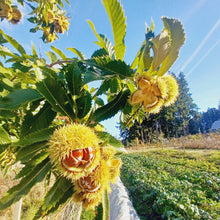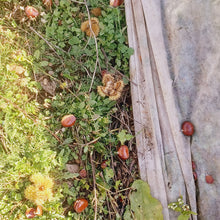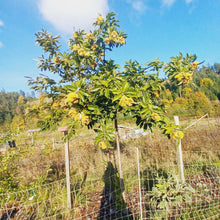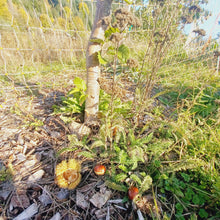| Selected for: | precocity (early bearing), nut size |
|
Mature height x width: |
approx 30' x 30' |
|
Recommended initial spacing: |
5-10' in rows 15-30' apart |
|
Recommended final spacing: |
approx 30' apart |
| Hardy to: | approx -20 to -25°C (-10 to -5°F) |
|
Preferred soil: |
well-drained, slightly acidic, sandy loam |
|
Good for: |
marginal or fertile land, productive / low-maintenance crop |
|
Uses: |
grain substitute, desserts, main dishes |
Chestnuts were once a crucial staple crop in many parts of North America, Europe, and Asia, and they are enjoying a resurgence. Nuts can be roasted, boiled, or dried and milled into a flour. Chestnut trees are low-maintenance, productive, and tolerant of drought and sandy/rocky soils. Spiky shells deter squirrels from getting to nuts before you do.
Genetics: Part of our Diverse Hybrid Chestnut Collection, the seed used for these seedlings is from a very precocious tree with large nuts which we believe has primarily European (Castanea sativa) genetics. This vigorous tree bore a crop at 5 years of age. Like E2C (although not to the same extent), the nuts have an inner skin (pellicle) that is difficult to remove and therefore taste bitter with some preparation methods. We found that they were best cut in half and boiled. The pellicle can then be removed but it takes some effort. A good choice if planting for livestock forage!
These chestnut seedlings are grown from seed that is collected from an orchard block planted with a diversity of Castanea genetics. We offer details about the mother trees of the seedlings but the fathers are unkown. The pollen could be from European, Chinese, Japanese or hybrid chestnut genetics and therefore the genetics of the seedlings will likely be some sort of hybrid. The orchard block is planted with seed from a variety of sources including from Gellatly's, Marlborough Street in Victoria, BC and modern ExJ varieties. There is minimal, if any, American chestnut genetics in this orchard block. This collection is for the curious and those who believe in the power of diversity and the resilience that it provides!
Planting: Chestnuts prefer well-drained, slightly acidic, sandy loam soil. They are intolerant of clay or wet soils. They are wind-pollinated so they require at least two to make nuts. Planting several in the same area helps to ensure adequate pollination. Requires watering for the first few years while they're getting established. Best planted when dormant (Nov-Mar) but can be planted later in spring.
Why seedlings? Growing seedlings from high-quality parents helps maintain diversity (each seed is a new variety) while drawing on some of the best genetics for chestnuts in our bioregion. In other words, you are breeding new, regionally-adapted chestnut varieties! Some trees may be poor producers or produce low quality nuts, so we recommend planting several of these trees closer together and selecting your final tree once they've produced their first nuts (3-5 years). Recommended final spacing is ~25' between the centre of each tree.
Why bare root? "Bare root" means that the tree has been grown in the ground (rather than in a pot). In general, bare root trees tend to have larger root systems because their roots aren't constricted by the edges of the pot. Because we don't need to use pots or potting soil, we can sell them more cheaply than potted trees. Bareroot trees must be planted when they are still dormant (Nov - Mar in our region).







